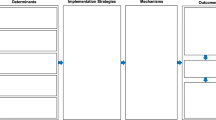Abstract
Objectives
Infant mortality remains a significant public health problem in the U.S. The Collaborative Improvement & Innovation Network (CoIIN) model is an innovative approach, using the science of quality improvement and collaborative learning, which was applied across 13 Southern states in Public Health Regions IV and VI to reduce infant mortality and improve birth outcomes. We provide an in-depth discussion of the history, development, implementation, and adaptation of the model based on the experience of the original CoIIN organizers and participants. In addition to the political genesis and functional components of the initiative, 8 key lessons related to staffing, planning, and implementing future CoIINs are described in detail.
Methods
This paper reports the findings from a process evaluation of the model. Data on the states’ progress toward reducing infant mortality and improving birth outcomes were collected through a survey in the final months of a 24-month implementation period, as well as through ongoing team communications.
Results
The peer-to-peer exchange and platform for collaborative learning, as well as the sharing of data across the states, were major strengths and form the foundation for future CoIIN efforts. A lasting legacy of the initiative is the unique application and sharing of provisional “real time” data to inform “real time” decision-making.
Conclusion
The CoIIN model of collaborative learning, QI, and innovation offers a promising approach to strengthening partnerships within and across states, bolstering data systems to inform and track progress more rapidly, and ultimately accelerating improvement toward healthier communities, States, and the Nation as a whole.



Similar content being viewed by others
References
Alabama, Florida, Georgia, Kentucky, Mississippi, North Carolina, South Carolina and Tennessee.
Arkansas, Louisiana, New Mexico, Oklahoma and Texas.
Gloor, P. A. (2006). Swarm Creativity: Competitive Advantage through Collaborative Innovation Networks. New York: Oxford University Press.
Hallman, Y. N. (2005) The Southern Regional Project on Infant Mortality: a 20-year retrospective. Atlanta: Southern Legislative Conference. http://www.slcatlanta.org/Publications/HSPS/infant_mortality/mortality_web/infant_mortality_web.pdf.
Heisler, E. J. (2012). The U.S. Infant Mortality Rate: International Comparisons, Underlying Factors, and Federal Programs. Washington: Congressional Research Service. http://www.cdc.gov/nchs/data/hus/hus14.pdf#listtables
Hirai, A. H., Sappenfield, W. M., Kogan, M. D., et al. (2014). Contributors to excess infant mortality in the U.S. South. American Journal of Preventive Medicine, 46(3), 219–227.
Institute for Healthcare Improvement. (2003). The Breakthrough Series: IHI’s Collaborative Model for Achieving Breakthrough Improvement. Boston: Institute for Healthcare Improvement.
Jacob, J. A. (2016). US Infant Mortality Rate Declines but Still Exceeds Other Developed Countries. JAMA, 315(5):451–452.
Lu, M. C., & Johnson, K. A. (2014). Toward a national strategy on infant mortality. American Journal of Public Health, 104(Suppl 1), S13–S16.
Maternal and Child Health Bureau. Collaborative Improvement and Innovation Network to Reduce Infant Mortality. http://www.mchb.hrsa.gov/infantmortality/coiin/index.html.
Mathews, T. J., MacDorman, M. F., & Thoma, M. E. (2015). Infant mortality statistics from the 2013 period linked birth/infant death data set. National vital statistics reports; vol 64 no 9. Hyattsville: National Center for Health Statistics.
McPherson ME, Gloor PA, Smith LA. (2015). Using Collaborative Improvement and Innovation Networks to Tackle Complex Population Health Problems. JAMA Pediatrics, 169(8):709–710.
Murphy, S., Xu, J., & Kochanek, K. (2012). Deaths: Preliminary Data for 2010. Hyattsville: National Center for Health Statistics.
U.S. Department of Health and Human Services. A “CoIIN” to Reduce Infant Mortality. http://www.hhs.gov/idealab/projects-item/coiin-reduce-infant-mortality/.
University of North Carolina. Region IV Network for Data Management and Utilization: project overview. http://www.shepscenter.unc.edu/data/rndmu/. Accessed 28 Sept 2015.
Wise, P. H. (2003). The anatomy of a disparity in infant mortality. Annual review of public health, 24, 341–362.
Xu, J. Q., Murphy, S. L., Kochanek, K. D., & Bastian, B. A. (2016). Deaths: Final data for 2013. National vital statistics reports; vol 64 no 2. Hyattsville: National Center for Health Statistics.
Acknowledgements
We would like to extend our deepest gratitude to the individuals and teams that made this work possible. Specifically, we would like to acknowledge the Strategy Team leads who provided invaluable leadership and expertise to the Regions IV and VI Infant Mortality CoIIN (alpha): Michelle Alletto, Wanda Barfield, Al Brann, Stephen Cha, Lekisha Daniel-Robinson, Suzanna Dooley, Rebekah Gee, Paul Halverson, David Lakey, Kate Menard, Carrie Shapiro-Mendoza, Ruth Ann Shepherd, Cathy Taylor, and Kim Wyche Etheridge. We would also like to acknowledge the Strategy Team Data and Methods Experts (alpha): Kay Johnson, Dabo Brantley, David Goodman, Lyn Kieltyka, Laurin Kasehagen, Cheryl Robbins, Bill Sappenfield.
Author information
Authors and Affiliations
Corresponding author
Rights and permissions
About this article
Cite this article
Ghandour, R.M., Flaherty, K., Hirai, A. et al. Applying Collaborative Learning and Quality Improvement to Public Health: Lessons from the Collaborative Improvement and Innovation Network (CoIIN) to Reduce Infant Mortality. Matern Child Health J 21, 1318–1326 (2017). https://doi.org/10.1007/s10995-016-2235-2
Published:
Issue Date:
DOI: https://doi.org/10.1007/s10995-016-2235-2




